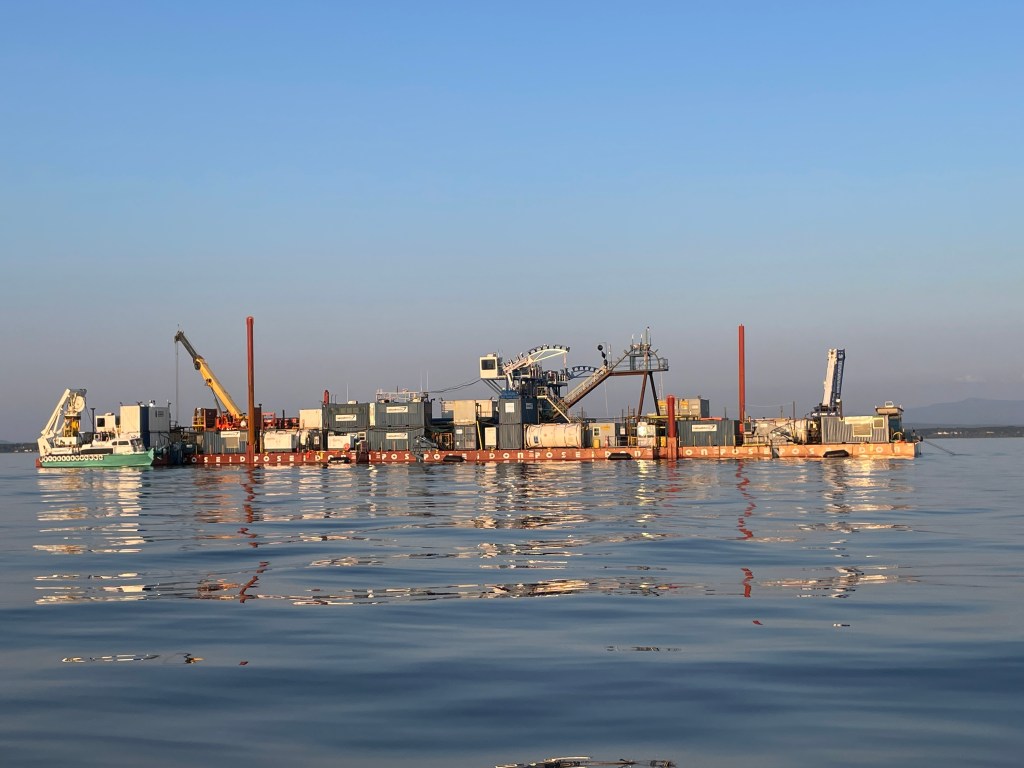Crew members on several barges floating on Lake Champlain are working to install a cable that stretches from the Canadian border to Queens, New York. The main barge houses equipment that installs cable under the lake bed, while multiple cable transportation barges hold approximately 12 miles of cable each. Photo courtesy of Gaye Symington
From afar, three barges in the middle of Lake Champlain may look like a floating amusement park, but in fact, they are part of a project to install a cable that is expected to provide New York City with 20% of its power.
The project, called the Champlain Hudson Power Express, led by Transmission Developers, is designed to bring hydropower electricity from HydroQuebec to New York City. Crew members are working to bury the cable, mostly underwater, from the project’s starting point at the Canadian border and running 339 miles south through Lake Champlain and the Hudson River to Queens, N.Y., where it will plug directly into the city’s electrical grid.
After a decade of planning and permitting, the project is expected to provide 1,250 megawatts of power, or the equivalent of powering more than a million New York homes.
The cable installation started in August, when workers began floating high-voltage direct current power cables on the surface of the lake, south of Rouses Point on the New York side of the lake, just south of the Canadian border, according to the project’s website.
Once the cable is in the correct position on the lake’s surface, divers and remotely operated vehicles work to lower it into the water, then bury it four feet below the lake bed. With three barges — one installation vessel and two for transporting cable — sections of cable can be floated and buried simultaneously.
In parts of the lake that are more than 150 feet deep, the cable will rest on the surface of the lake bed, surrounded by a protective duct.
Currently, the barges are near Port Kent, New York — across from Malletts Bay in Vermont — where they just completed a splice, Lindsey Jordan, a spokesperson for the project, said in an email. Next, the barges are planning to lay about 12 miles of cable until they reach the next splice location, which is about two miles north of Essex, New York, Jordan said. The barges are likely to remain on the lake through the end of the year, she said.
Barges carry cable for the Champlain Hudson Power Express on Lake Champlain. Photo courtesy of the Champlain Hudson Power Express
The project’s path navigates around sensitive areas at the lake’s bottom, including Lake Champlain’s many shipwrecks. Vessels use GPS and an underwater acoustic positioning system to make sure they’re laying the cable in the correct position.
“Proximity to cultural resources and existing infrastructure in the lake were taken into account during the design of the approval cable route. This included extensive work with the Lake Champlain Maritime Museum to identify culturally sensitive areas in the Lake,” Jordan said in an email.
The state of Vermont did not have a direct stake in the project as the cable’s path is set to remain entirely on the New York side of the lake. Still, project leaders have “spoken to reporters in Vermont, held meetings with those in the maritime community in Vermont and the State of Vermont government is aware of the project,” Jordan said.
The project required permits from the U.S. Army Corps of Engineers, the U.S. Department of Energy and the State of New York.
While the project does not cross into Vermont’s borders, environmental organizations based in Vermont may stand to benefit from it. Champlain Hudson Power Express has set aside a trust of $117 million, to be distributed over a 35 year period, to advance environmental protection efforts in both the Champlain and Hudson basins.
Lake Champlain Basin Program, based in Grand Isle, is helping to coordinate the distribution of those funds, which are going to be designated to “high-priority research projects for habitat and fish survey work and invasive species work” in the Lake Champlain basin, according to Meg Modley, aquatic invasive species management coordinator with the organization.
“The top priority projects are related to invasive species spread prevention, so looking at ways that we can mitigate invasive species from moving in between the Champlain drainage and the Richelieu River and the St. Lawrence to our north, as well as the Champlain Canal and the Hudson drainage to our south,” Modley said.
Modley said the organization is beginning the process to select projects for the first $5 million round of funding, which is soon to become available.
Read the story on VTDigger here: Big barges help install cable for New York power project in Lake Champlain.

